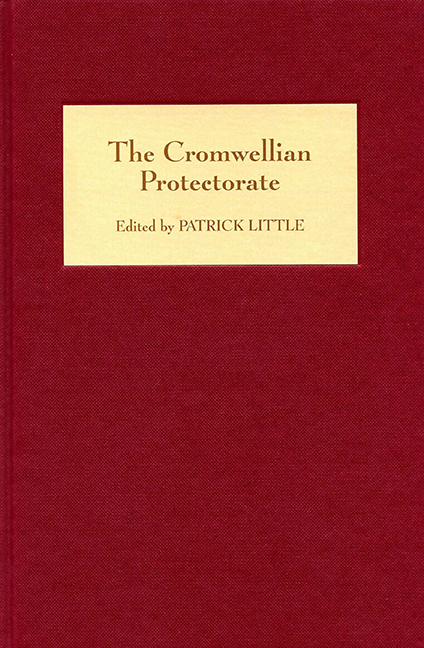Book contents
- Frontmatter
- Contents
- List of Illustrations
- Preface
- Notes on Contributors
- Abbreviations
- 1 Introduction
- 2 Oliver Cromwell and the Protectorate Parliaments
- 3 The Protector Humbled: Richard Cromwell and the Constitution
- 4 Cromwellian Style: The Architectural Trappings of the Protectorate Regime
- 5 Oliver Cromwell and the Council
- 6 ‘To Create a Little World out of Chaos’: The Protectoral Ordinances of 1653–1654 Reconsidered
- 7 The Irish and Scottish Councils and the Dislocation of the Protectoral Union
- 8 ‘This Murmuring and Unthankful Peevish Land’: Wales and the Protectorate
- 9 Cromwellian Towns in the Severn Basin: A Contribution to Cis-Atlantic History?
- 10 Policing the Cromwellian Church: The Activities of the County Ejection Committees, 1654–1659
- Index
6 - ‘To Create a Little World out of Chaos’: The Protectoral Ordinances of 1653–1654 Reconsidered
Published online by Cambridge University Press: 24 October 2017
- Frontmatter
- Contents
- List of Illustrations
- Preface
- Notes on Contributors
- Abbreviations
- 1 Introduction
- 2 Oliver Cromwell and the Protectorate Parliaments
- 3 The Protector Humbled: Richard Cromwell and the Constitution
- 4 Cromwellian Style: The Architectural Trappings of the Protectorate Regime
- 5 Oliver Cromwell and the Council
- 6 ‘To Create a Little World out of Chaos’: The Protectoral Ordinances of 1653–1654 Reconsidered
- 7 The Irish and Scottish Councils and the Dislocation of the Protectoral Union
- 8 ‘This Murmuring and Unthankful Peevish Land’: Wales and the Protectorate
- 9 Cromwellian Towns in the Severn Basin: A Contribution to Cis-Atlantic History?
- 10 Policing the Cromwellian Church: The Activities of the County Ejection Committees, 1654–1659
- Index
Summary
My lord, the state and complexion of affairs are much altered here since you left us and I think very much for the better … The government now established is by a lord protector (who hath much the same power which the king formerly) assisted with a council not exceeding twenty-one and parliaments to be chosen triennially who have the legislature wholly in them, save for some time till the first parliament be elected when it rests in the protector and his council. The nation is much generally satisfied with it and Providence seems to promise us a great deal of settlement and peace under this government.
On 7 January 1654 one of the new councillors, Sir Charles Wolseley, wrote thus to the politician and diplomat Bulstrode Whitelocke, then in Sweden, to inform him of recent constitutional developments at home. Wolseley had played a leading role in ending the former regime and had been appointed to the protectoral council. An insider, with a case to make and position to defend, he was one of several politicians and propagandists who praised the incoming regime and constitution. On the previous day the journalist Marchamont Nedham had written in similar tones to Whitelocke, announcing that ‘we have a new world formed (like the old) out of chaos, by the prudence and industry of that excellent person’ the new protector. By then Nedham was almost certainly preparing a more considered apologia for the protectoral regime, published in early February as A True State of the Case of the Commonwealth. It was here, while justifying the events giving rise to the protectorate and analysing the new written constitution that Nedham noted that in December 1653 ‘we were in the beginning of a new government, necessitated to create a little world out of chaos, and bring form out of confusion’.
In A True State, Nedham sought to emphasise how the new constitution gave power directly or indirectly to the people and elected parliaments. He stressed the authority of parliament and the limited role of the executive arm, demonstrating how the protector and his new executive council were answerable to parliament and how in time councillors and, via them, the head of state himself would be drawn from candidates selected by parliament.
- Type
- Chapter
- Information
- The Cromwellian Protectorate , pp. 105 - 126Publisher: Boydell & BrewerPrint publication year: 2007

